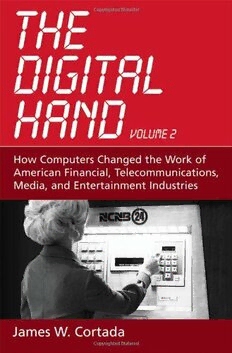
The Digital Hand: How Computers Changed the Work of American Financial, Telecommunications, Media, and Entertainment Industries: 2 PDF
Preview The Digital Hand: How Computers Changed the Work of American Financial, Telecommunications, Media, and Entertainment Industries: 2
The DIGITAL HAND This page intentionally left blank J A M E S W. C O R T A D A The DIGITAL HAND Volume II How Computers Changed the Work of American Financial, Telecommunications, Media, and Entertainment Industries 1 2006 1 OxfordUniversityPress,Inc.,publishesworksthatfurther OxfordUniversity’sobjectiveofexcellence inresearch,scholarship,andeducation. Oxford NewYork Auckland CapeTown DaresSalaam HongKong Karachi KualaLumpur Madrid Melbourne MexicoCity Nairobi NewDelhi Shanghai Taipei Toronto Withofficesin Argentina Austria Brazil Chile CzechRepublic France Greece Guatemala Hungary Italy Japan Poland Portugal Singapore SouthKorea Switzerland Thailand Turkey Ukraine Vietnam Copyright(cid:1)2006byOxfordUniversityPress,Inc. PublishedbyOxfordUniversityPress,Inc. 198MadisonAvenue,NewYork,NewYork10016 www.oup.com OxfordisaregisteredtrademarkofOxfordUniversityPress Allrightsreserved.Nopartofthispublicationmaybereproduced, storedinaretrievalsystem,ortransmitted,inanyformorbyanymeans, electronic,mechanical,photocopying,recording,orotherwise, withoutthepriorpermissionofOxfordUniversityPress. LibraryofCongressCataloging-in-PublicationData Cortada,JamesW. Thedigitalhand.HowcomputerschangedtheworkofAmericanfinancial,telecommunications, media,andentertainmentindustries/JamesW.Cortada. p.cm Includesbibliographicalreferencesandindex. ISBN–10:0–19–516587–X ISBN–13:978–0–19–516587–6 1. Informationtechnology—Economicaspects—UnitedStates—Casestudies. 2. Technologicalinnovations— Economicaspects—UnitedStates—Casestudies. 3. Business—Dataprocessing—Casestudies. I. Title:How computerschangedtheworkofAmericanfinancial,telecommunications,media,andentertainment industries. II. Title. HC110.I55C672005 338'.064'0973—dc22 2004030363 9 8 7 6 5 4 3 2 1 PrintedintheUnitedStatesofAmerica onacid-freepaper Tothreegreateditorswhotaughtmehowtowritebooks,thenpublishedthem: JamesSabin PaulBecker HerbAddison This page intentionally left blank PREFACE Itisalwaysoftheutmostimportanceforustobethoroughlymastersofthe economichistoryofthetime,thecountryortheindustry,sometimesevenof theindividualfirminquestion,beforewedrawanyinferenceatallfromthe behavioroftimeseries. —JosephA.Schumpeter,1939 Thegreateconomistquotedabovepointsthewayforthesearchinunderstand- inghowmoderneconomieswork.Hedidmorethanmosteconomiststocall attention to the growing influence of technology on business and economic cir- cumstances.Thisbooktakesoneprimarycollectionoftechnologies(computing) andasecondaryset(telecommunications)andexploresthepathSchumpeterurged ustotakebecauseuseofthesemethodschangedprofoundlyhowpeopledidtheir daily work across the American economy in the second half of the twentieth century.Computers,inparticular,influencedenormouslyhowcompanies,andthe industriesinwhichtheyresided,functioned.Conversely,industriesplayedamuch greater role in the deployment of computers in the economy than was thought even just a few years ago. The implications of these findings are important both for scholars of the modern American economy and for managers workingwithin it. This book describes how computers were used in a variety of industries, how they influenced companies and industries over time, and what, ultimately, were thetechnological“sweetspots.” Thisbookispartofalargerprojecttodocumenttheroleandeffectsofcom- putingacrosstheAmericaneconomyoverthelatterpartofthetwentiethcentury. Inthefirstvolume,TheDigitalHand:HowComputersChangedtheWorkofAmer- icanManufacturing,Transportation,andRetailIndustries(2004),Iarguethatinfor- mation technology (IT) profoundly influenced the daily activities of a large col- lection of industries. I focus on the physical economy—that is to say, on the manufacture, movement,andsaleofgoods. Inthecourseoflookingat16 indus- tries,Idescribehowdigitaltechnologiessoprofoundlychangedthenatureofwork viii Preface that, in fact, a whole new style of doing business had emerged by the end of the century.Yetitisastorynotcomplete,becauseitisstillunfoldingatthedawnof the new century. In this second book, I turn our attention to other sectors that havetraditionallyreliedmoreonsellinginformationratherthangoods,andthat alsowereearlyadoptersofavarietyofdigitalandtelecommunicationtools.Asin the earlier book, I contend that the influence of the digital hand and its effects on economic activity were and are as important as management’sactionsonthe economy and a natural extension of its role. Using the tools of the historian to writeanarrativeaccount,Idemonstratethatprocessatworkinthedozenindus- tries described in this book. For the techniques used, and the rationale behind them,IencouragethereadertogotoAppendixAoftheearlierbook. Mylong-termobjectiveistostudyenoughindustriestobeabletogeneralize, withconfidence,abouttheroleofcomputingin80percentormoreoftheecon- omy.Iintendtoaccomplishthistaskacrossthreebooks.Thefirstconcernedthe physicaleconomy,thisonemoreoftheinformation-centeredportionoftheecon- omy, and the third will look at the public sector (for example, government and education). I am learning through research across all three books that there are many common patterns of behavior that appear in scores of industries. But, just asthefirstbookhadtostandonitsown,sotoomustthisonefortheindustriesit describes. Theindustriesselectedforthiscurrentvolume—fromthefinancial,telecom- munications,mediaandentertainmentsectorsoftheeconomy—allshareseveral commonfeaturesthatledtoanaturalgrouping.First,theindustriesareextensive usersoftelephonictechnologies.Second,theyuseavarietyofcomputertechnol- ogiesandhavedonesoforthebulkoftheperiodweareexamining.Third,their centralproducts areinformation,data,andexperiences—notgoods(suchascars or groceries)—and their primary inventory is information. Banks, for instance, keep more data about dollars than actual cash on hand; radio stations transmit informationover the airwaves; while a phone companymakes itpossibleforyou and me to distribute both conversation and data. Fourth, they are increasingly being seen as core pillars of what has come to be called the Information Age or InformationSociety,soweneedtounderstandinsomedetailthemakeupofthose pillars. Fifth, and perhaps most subtly, these industries are not so much merging together,asmanyhaveargued,astheyareincreasingtheinteractionsamongthem by using digital technologies. If that trend continues, one can easily expect that wewillhavemovedtoapostindustrialeconomy,onethatalsoincludestheman- ufacture, distribution, and sale of goods, not just the movement of information. As I demonstrated in the earlier volume and reinforce in this one, the emerging postindustrialeconomyisnotonethatisreducingitsoutputofgoods.Rather,the “new” economy continues to play out its historic role of providing the physical necessities and wants of life at the same time that it also expands human inter- actionsconsideredvitaltothefunctionsofaneconomyandasocietyatlarge.The result is less a retreat from the role of the “old” economy than an evolution to a new style of accomplishing its historic purposes. To be sure, how work was done Preface ix in2000differedinmanywaysfromhowitwasdonein1950,butbusinessagendas hadnot.Banksstillhadcheckingaccounts,madeloans,worriedaboutbadcredit risks, and served as the nation’s channel of distribution for cash from the U.S. government to the public at large. Insurance companies still sold insurance and madeprofits.Radioandtelevisionstationsstillinformedandentertained. Asintheearlierbook,Ilookathowcomputerswereusedinspecificindustries overthelasthalfofthetwentiethcentury,againfocusingontheAmericanecon- omysinceitwastheearliestadopterofthecomputer.Ilookathowmanagement cametousecomputersandtheinfluencethecomputershadontheindustries.To demonstratehowprofoundlycomputersaffectedthenatureofwork,Idiscusshow applicationswereextensivelydeployedwithinindustriesandsubsequentlybrought aboutadoptionsorchangesattheindustryandfirmlevels. A subtext of this book is the lack of a computer revolution and indeed the digitalevolutionthatoccurred.Inoneindustryafteranother,firmsandtheirman- agementteamsincrementallyadoptedcomputers;overtime,theaccumulateduses andtransformationsbroughtaboutbythesemillionsofindividualadoptionscon- stituted a metamorphosis so great that one could easily jump to the conclusion that a revolution had occurred. But the insight about how the change occurred has much to teach us about how to embrace a newtechnology and how,infact, managersandtheirfirmsandindustrieschangeovertime.Thus,wecanbeginto movefromgeneralitiesandhypetoamoresolidlygroundedsetofoperatingprin- ciplesandinsightsaboutchange,innovation,andtransformationsinthemodern economyatthreelevels:firm,industry,andnationaleconomy. The case for looking at the adoption of the computer on an industry-by- industrybasiswasexplainedintheearlierbook.Tosummarize:companieslooked to their industry’s publications, conferences, members, and competitors to deter- mine how they should use computers and other resources. These other resources included management practices and changes in government regulations,because technology by itself was never all-pervasive, operating in some abstract way, but rather part of a larger mosaic of activities and influences that affectedindustries, individuals,andthetechnologiesthemselves.Inturn,activitieswithinindustries did influence the attitudes of individuals and firms, who then influenced their colleagues and competitors. Some uses of computers were also unique to their industries, as happened with scanning in retail, ATMs in banking, and telecom- munications in the telephone industry. To get down to the level of specificity neededinordertounderstandmorepreciselyhowcomputersaffectedtheAmer- ican economy and either helped or hurt its enormous success during the half century,weneedtolookatcomputinginspecificindustries.Thatiswhythebulk of this book is a collection of industry overviews with descriptions of how they used computers. I consider this exercise an essential first step—but only a first step—towardfulfillingSchumpeter’sdictate. In the earlier volume, I used the prism of digital technologies, focusing on howthesewereusedovertime,toshedlightonhowtheworkoftheU.S.economy evolved.Mostusesofdigitaltechnologies—thecomputerchipforinstance—were intheformsofcomputersandtelecommunications.Theseuseswerelargelybased
